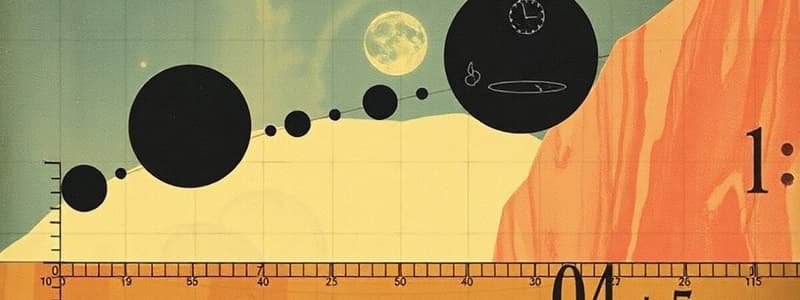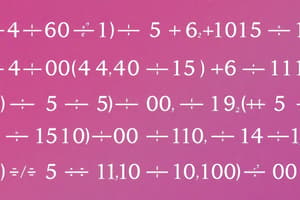Podcast
Questions and Answers
A sequence alternates between positive and negative values. What expression involving -1 would typically be included in the general term $T_n$ to account for this?
A sequence alternates between positive and negative values. What expression involving -1 would typically be included in the general term $T_n$ to account for this?
- $(-1)^n$ or $(-1)^{n+1}$ (correct)
- $-n$ only
- $(-n)^2$ only
- $(-1)^{-n}$ only
In a sequence that alternates signs, which of the following determines whether to use $(-1)^n$ or $(-1)^{n+1}$ in the general term?
In a sequence that alternates signs, which of the following determines whether to use $(-1)^n$ or $(-1)^{n+1}$ in the general term?
- Whether the common difference is positive or negative
- Whether the first term is positive or negative (correct)
- Whether the last term is positive or negative
- Whether the number of terms is even or odd
If a sequence starts with a negative term followed by a positive term, and then alternates, which expression is most likely to be part of the general term?
If a sequence starts with a negative term followed by a positive term, and then alternates, which expression is most likely to be part of the general term?
- $(-n)^2$
- $(-1)^{n}$
- $(-1)^{n+1}$ (correct)
- $(-1)^{-n}$
Consider the sequence: $\frac{1}{2}, \frac{1}{6}, \frac{1}{12}, ...$ What is a likely general term for this sequence?
Consider the sequence: $\frac{1}{2}, \frac{1}{6}, \frac{1}{12}, ...$ What is a likely general term for this sequence?
If $T_n = \frac{(-1)^n}{n^2 + 1}$, what is the value of the third term in the sequence?
If $T_n = \frac{(-1)^n}{n^2 + 1}$, what is the value of the third term in the sequence?
If a sequence is defined by the general term $T_n = 3n^2 - 1$, what is the value of the fourth term ($T_4$)?
If a sequence is defined by the general term $T_n = 3n^2 - 1$, what is the value of the fourth term ($T_4$)?
Consider a sequence where the general term is given by $T_n = \frac{n}{n+1}$. What happens to the value of $T_n$ as n becomes very large?
Consider a sequence where the general term is given by $T_n = \frac{n}{n+1}$. What happens to the value of $T_n$ as n becomes very large?
A sequence is defined recursively as $T_1 = 3$ and $T_{n+1} = T_n + 5$ for $n ≥ 1$. What is the value of the third term ($T_3$)?
A sequence is defined recursively as $T_1 = 3$ and $T_{n+1} = T_n + 5$ for $n ≥ 1$. What is the value of the third term ($T_3$)?
Which of the following sequences is a decreasing sequence?
Which of the following sequences is a decreasing sequence?
Given the recursive sequence defined by $T_1 = 1$ and $T_{n+1} = (T_n)^2 + 1$, find the value of $T_4$.
Given the recursive sequence defined by $T_1 = 1$ and $T_{n+1} = (T_n)^2 + 1$, find the value of $T_4$.
A sequence is given by the general term $T_n = \frac{(-1)^n}{n^2}$. What can be said about the terms of this sequence as n increases?
A sequence is given by the general term $T_n = \frac{(-1)^n}{n^2}$. What can be said about the terms of this sequence as n increases?
Consider the sequence defined by $T_n = \frac{n^2 - 1}{n + 1}$. What is a simplified expression for $T_n$?
Consider the sequence defined by $T_n = \frac{n^2 - 1}{n + 1}$. What is a simplified expression for $T_n$?
Which of the following recursive definitions will generate the sequence: 3, 6, 12, 24, ...?
Which of the following recursive definitions will generate the sequence: 3, 6, 12, 24, ...?
Flashcards
What is a general term (Tn)?
What is a general term (Tn)?
A formula that expresses any term of a sequence as a function of its position (n).
How to handle alternating signs in a sequence?
How to handle alternating signs in a sequence?
Include (-1)^n or (-1)^(n+1) in the general term.
How to choose between (-1)^n and (-1)^(n+1)?
How to choose between (-1)^n and (-1)^(n+1)?
If the first term is positive, use (-1)^(n+1). If negative, use (-1)^n.
How to verify a general term?
How to verify a general term?
Signup and view all the flashcards
What is a sequence?
What is a sequence?
Signup and view all the flashcards
What is the general term of a sequence?
What is the general term of a sequence?
Signup and view all the flashcards
What does T1, T2, T3,...represent?
What does T1, T2, T3,...represent?
Signup and view all the flashcards
What is an Increasing Sequence?
What is an Increasing Sequence?
Signup and view all the flashcards
What is a Decreasing Sequence?
What is a Decreasing Sequence?
Signup and view all the flashcards
How to find terms from the general term?
How to find terms from the general term?
Signup and view all the flashcards
What is a Recursive Sequence?
What is a Recursive Sequence?
Signup and view all the flashcards
What do you need to start a recursive sequence?
What do you need to start a recursive sequence?
Signup and view all the flashcards
Study Notes
Introduction to Sequences
- Sequences are a core topic in the mathematics curriculum.
- This is often the first lesson in a term, aiming to comprehensively cover sequences.
- The math curriculum includes algebra, trigonometry, calculus, and sequences/series.
- Knowledge of sequences and series is useful for advanced math.
Sequences: The Basics
- Sequences can involve addition, subtraction, multiplication, or division to find the next term.
- The pattern of these numbers is a sequence.
- A sequence follows a specific rule or pattern.
- The general term of a sequence is denoted as Tn.
- Tn represents the entire sequence.
- T followed by a number (e.g., T1, T2, T3) denotes specific terms.
- T1 is the first term, T2 is the second term, and so on.
- Tn is also known as the "General Term," and is used to find any term in the sequence.
Sequence Types and Finding Terms
- Questions about sequences usually involve finding terms from a general term or finding the general term from a given sequence.
- In an increasing sequence the values increase, and in a decreasing sequence the values decrease.
- The values increase in an increasing sequence.
- The values decrease in a decreasing sequence.
- When given a general term, you can find the terms of a sequence by substituting consecutive natural numbers into the general term.
- For example, given Tn = 2n - 3, to find first 5 items of the sequence, substitute 1, 2, 3, 4, 5 into the equation.
- Another example is calculating terms for Tn = (-1)^n / (n+3).
Recursive Sequences
- In recursive sequence examples, the value of a term depends on the value of the previous term.
- For example: T1 = 2, and Tn+1 = 2 * Tn.
- The first term is given, and each subsequent term is found by multiplying the previous term by 2.
- To find T2, multiply T1 by 2, resulting in 4; to find T3, multiply T2 by 2, and so on.
Finding the General Term
- Guidance is provided on how to find the general term Tn, especially when the sequence alternates between positive and negative values.
- If a sequence alternates between positive and negative, account for this by including (-1)^n or (-1)^(n+1) in the general term.
- The choice between using n or n+1 in the exponent depends on whether the first term is positive or negative.
- If the sequence alternates signs (positive, negative, positive, negative), include "negative 1 to the power of n" in the general term.
- If the signs alternate, the expression (-1)^n accounts for this change in sign.
Finding the General Term Examples
- Several examples for finding the general term exist.
- One example involves matching a general term to these sequence values: one over two, one over six, one over twelve etc...
- Substitute numbers for "n" into the general term, until the correct general term satisfying the sequence is found.
- The goal is to build a foundational understanding of sequences, including identifying patterns, finding specific terms, and determining general terms.
Studying That Suits You
Use AI to generate personalized quizzes and flashcards to suit your learning preferences.




